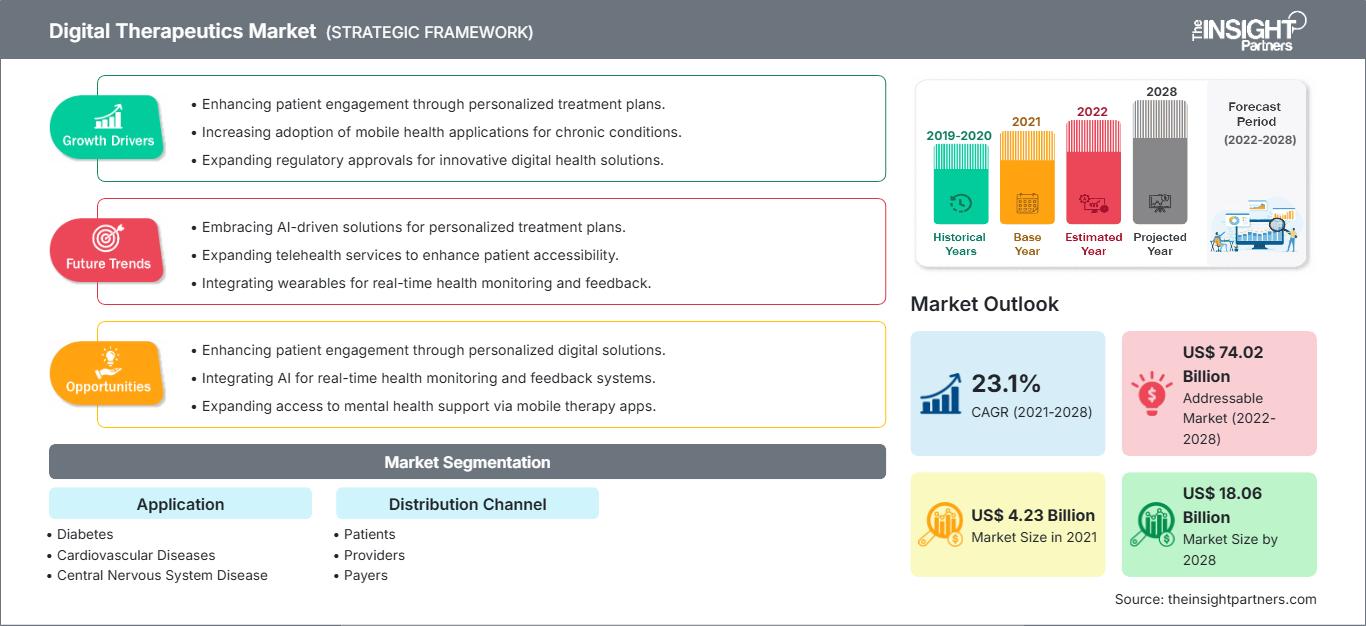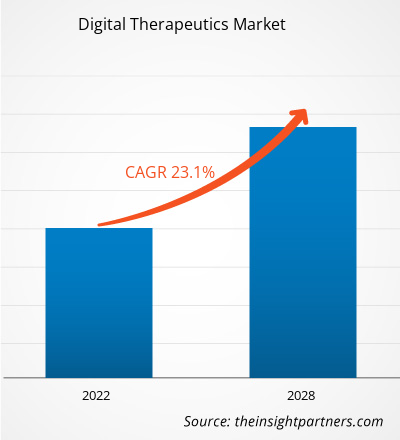[Rapport de recherche] Le marché des thérapies numériques était évalué à 4 226,94 millions de dollars américains en 2021 et devrait atteindre 18 061,79 millions de dollars américains d'ici 2028 ; il devrait enregistrer un TCAC de 23,1 % de 2022 à 2028.
Point de vue de l'analyste
Le marché devrait être stimulé par la prévalence croissante des smartphones dans les pays développés et émergents, la rentabilité des technologies de santé numériques pour les prestataires et les patients, et la demande croissante de systèmes de santé intégrés et de traitements centrés sur le patient. Selon Kepios, il y aura 4,27 milliards d'utilisateurs d'Internet dans le monde en avril 2021, soit plus de 60 % de la population mondiale. À mesure que ce nombre augmente, la sensibilisation au suivi intelligent de la santé devrait s'améliorer. Les consommateurs des économies développées sont de plus en plus conscients des articles médicaux innovants pour le traitement des troubles médicaux. Selon l'Organisation de coopération et de développement économiques, les dépenses de santé en proportion du PIB ont considérablement augmenté en 2020, la situation économique de plusieurs pays de l'OCDE s'étant dégradée et les dépenses de santé ayant augmenté. En conséquence, la préférence s'est déplacée vers les services médicaux avancés, notamment la demande accrue de dispositifs thérapeutiques avancés. L'acceptation des produits est un autre facteur stimulant l'expansion du marché.
Aperçu du marché
Les thérapies numériques offrent aux patients des solutions thérapeutiques fondées sur des données probantes, axées sur le traitement des maladies grâce à des programmes et une gestion utilisant des logiciels de haute qualité. Les thérapies numériques ont progressé ces dernières années, exploitant la technologie pour compléter ou potentiellement remplacer la thérapie clinique traditionnelle. Elles sont utilisées indépendamment ou en complément des dispositifs, des médicaments ou d'autres thérapies afin d'optimiser les soins aux patients et les résultats de santé. Les principaux facteurs contribuant à la croissance du marché des thérapies numériques sont la prévalence croissante des maladies chroniques, les préoccupations concernant la nécessité de réduire les coûts de santé, ainsi que les partenariats et les collaborations entre entreprises. Cependant, la croissance du marché est freinée par la cybermenace et l’augmentation de la sécurité des données, ce qui limite ses applications potentielles dans le domaine médical.
Vous bénéficierez d’une personnalisation sur n’importe quel rapport - gratuitement - y compris des parties de ce rapport, ou une analyse au niveau du pays, un pack de données Excel, ainsi que de profiter d’offres exceptionnelles et de réductions pour les start-ups et les universités
Marché des thérapies numériques: Perspectives stratégiques

-
Obtenez les principales tendances clés du marché de ce rapport.Cet échantillon GRATUIT comprendra une analyse de données, allant des tendances du marché aux estimations et prévisions.
Moteur du marché
La prévalence croissante des maladies chroniques stimulera la croissance du marché des thérapies numériques
Les maladies chroniques, notamment les maladies cardiaques, les accidents vasculaires cérébraux, le diabète et l'obésité, représentent la majeure partie des coûts de santé de tous les pays. Selon un rapport de l'Organisation mondiale de la santé (OMS), 463 millions d'adultes dans le monde étaient diabétiques en 2020, et ce nombre devrait atteindre 629 millions d'ici 2045. L'Asie-Pacifique, l'Europe, le Moyen-Orient et l'Afrique signalent une forte prévalence du diabète. Cette maladie se caractérise principalement par une régulation inadéquate de la glycémie due à l'incapacité de l'organisme à produire ou à utiliser efficacement l'hormone insuline, et ne dispose d'aucun traitement spécifique. Selon l'Atlas du diabète 2021 de la FID, publié par la Fédération internationale du diabète, l'Amérique du Nord comptait environ 51 millions de personnes atteintes de diabète en 2021, et ce chiffre devrait atteindre 63 millions d'ici 2045. De plus, l'Asie du Sud-Est compte environ 16,8 % de la population mondiale de personnes diabétiques. D'ici 2035, environ 130 millions d'adultes aux États-Unis devraient souffrir d'une forme ou d'une autre de maladie cardiovasculaire. Les taux d'obésité augmentent rapidement dans les économies développées et en développement du monde entier en raison de modes de vie sédentaires et malsains. Selon les données publiées par l'Organisation de coopération et de développement économiques (OCDE) en 2017, environ 19,5 % de la population adulte était obèse dans la zone OCDE. Ce taux est inférieur à 6 % en Corée et au Japon, et supérieur à 30 % en Hongrie, en Nouvelle-Zélande, au Mexique et aux États-Unis. De plus, la prévalence a augmenté rapidement en Australie, au Canada, au Chili, en Afrique du Sud et au Royaume-Uni au cours de la dernière décennie, avec environ 25 % ou plus d'adultes obèses. Les taux d'obésité devraient atteindre respectivement environ 47 %, 39 % et 35 % aux États-Unis, au Mexique et en Angleterre d'ici 2030.
Afin d'améliorer la gestion des maladies chroniques et d'offrir davantage d'options de traitement aux patients, les thérapies numériques contribuent à fournir des solutions thérapeutiques fondées sur des données probantes. Elles permettent aux patients de mieux contrôler leurs soins et offrent des solutions potentielles pour la gestion des maladies chroniques, comme le diabète. Par conséquent, l'augmentation de la prévalence des maladies chroniques stimule le marché des thérapies numériques.
Analyse segmentaire
Informations basées sur les applications
En fonction des applications, le marché des thérapies numériques est segmenté en maladies respiratoires, maladies du système nerveux central, sevrage tabagique, maladies musculo-squelettiques, maladies cardiovasculaires, diabète et autres applications. En 2021, le segment du diabète détenait la plus grande part de marché des thérapies numériques et devrait enregistrer le TCAC le plus élevé du marché au cours de la période de prévision en raison de l'augmentation de l'incidence du diabète dans le monde, de la forte prévalence de l'obésité dans les pays en développement et des risques et coûts économiques importants associés aux maladies liées à l'obésité.
Le diabète est une maladie chronique potentiellement mortelle sans traitement spécifique. Il est principalement causé par l'incapacité de l'organisme à produire ou à utiliser efficacement l'hormone insuline. Cette incapacité empêche l'organisme de réguler correctement la glycémie. Il existe deux types de diabète : le diabète de type I, également appelé diabète insipide, et le diabète de type II, également appelé diabète sucré. L'incidence et la prévalence du diabète augmentent régulièrement dans le monde. Le diabète de type 2 est la forme de diabète la plus répandue et a augmenté parallèlement aux changements culturels et sociétaux. Dans les pays à revenu élevé, jusqu'à 91 % des adultes atteints de la maladie souffrent de diabète de type 2. Selon l'Atlas 2021 de la Fédération internationale du diabète (FID), environ 537 millions de personnes vivent avec le diabète et ce chiffre devrait atteindre 643 millions d'ici 2030 dans le monde.
Informations sur les canaux de distribution
En termes de canaux de distribution, le marché des thérapies numériques est divisé en patients, prestataires, payeurs et employeurs. Le segment des patients détenait la plus grande part de marché des thérapies numériques en 2021. Cependant, le segment des prestataires devrait enregistrer le TCAC le plus élevé au cours de la période de prévision.
Aperçu régional du marché des thérapies numériques
Les tendances régionales et les facteurs influençant le marché des thérapies numériques tout au long de la période de prévision ont été analysés en détail par les analystes de The Insight Partners. Cette section aborde également les segments et la géographie du marché des thérapies numériques en Amérique du Nord, en Europe, en Asie-Pacifique, au Moyen-Orient et en Afrique, ainsi qu'en Amérique du Sud et en Amérique centrale.
Portée du rapport sur le marché des thérapies numériques
| Attribut de rapport | Détails |
|---|---|
| Taille du marché en 2021 | US$ 4.23 Billion |
| Taille du marché par 2028 | US$ 18.06 Billion |
| TCAC mondial (2021 - 2028) | 23.1% |
| Données historiques | 2019-2020 |
| Période de prévision | 2022-2028 |
| Segments couverts |
By Application
|
| Régions et pays couverts |
Amérique du Nord
|
| Leaders du marché et profils d'entreprises clés |
|
Densité des acteurs du marché des thérapies numériques : comprendre son impact sur la dynamique des entreprises
Le marché des thérapies numériques connaît une croissance rapide, porté par une demande croissante des utilisateurs finaux, due à des facteurs tels que l'évolution des préférences des consommateurs, les avancées technologiques et une meilleure connaissance des avantages des produits. Face à cette demande croissante, les entreprises élargissent leur offre, innovent pour répondre aux besoins des consommateurs et capitalisent sur les nouvelles tendances, ce qui alimente la croissance du marché.

- Obtenez le Marché des thérapies numériques Aperçu des principaux acteurs clés
- Analyse historique (2 ans), année de base, prévision (7 ans) avec TCAC
- Analyse PEST et SWOT
- Taille du marché Valeur / Volume - Mondial, Régional, Pays
- Industrie et paysage concurrentiel
- Ensemble de données Excel
Rapports récents
Rapports connexes
Témoignages
Raison d'acheter
- Prise de décision éclairée
- Compréhension de la dynamique du marché
- Analyse concurrentielle
- Connaissances clients
- Prévisions de marché
- Atténuation des risques
- Planification stratégique
- Justification des investissements
- Identification des marchés émergents
- Amélioration des stratégies marketing
- Amélioration de l'efficacité opérationnelle
- Alignement sur les tendances réglementaires






















 Obtenez un échantillon gratuit pour - Marché des thérapies numériques
Obtenez un échantillon gratuit pour - Marché des thérapies numériques